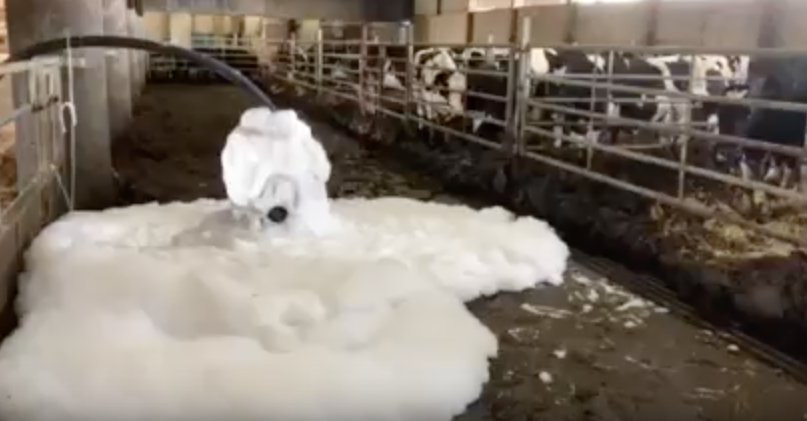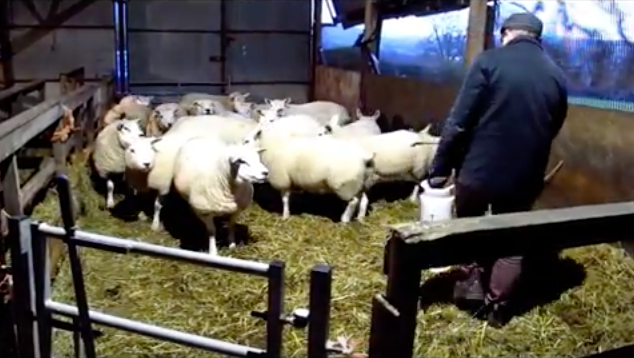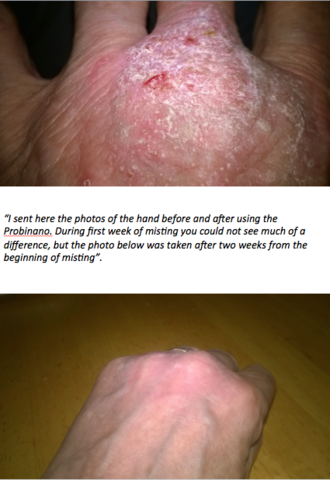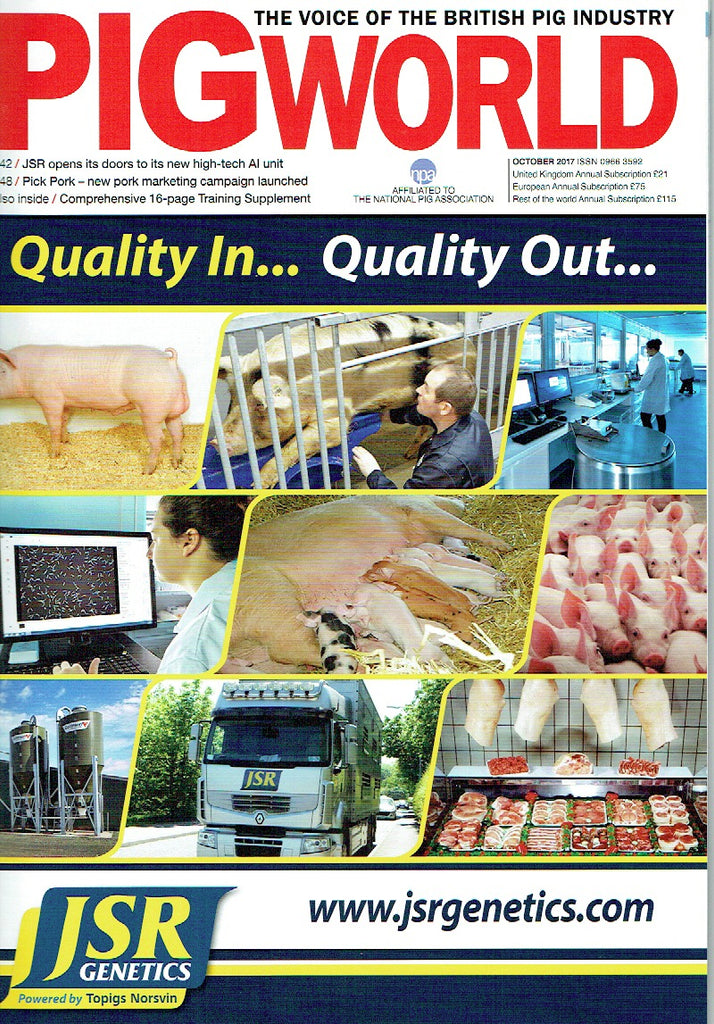News
How can generating this foam help with beef animal weight gain and reduce the need for antibiotics in agriculture?
A question we're often asked is, Why we generate foam to help reduce the risk of lameness in cattle? So, we thought we'd ask you. Why do you think we generate a foam to help reduce the need for antibiotics in agriculture?
Clean water for clean milk
The UK Mastitis Control Plan clearly states that mains water is preferred to on farm sources due to lower bacterial pressure on the animals that drink it from their troughs, bowls or vessels. But cows drink large volumes of water. But do they drink as much as they could do? Is their milk yield potential under achieved due to putrid tasting water? Does water infected by bad bacteria challenge their immune system and ultimately cause infections?
Helping farmers clean their water sources is an area Pruex specialise in.
Clean feet for clean milk
Lowering the amount of antibiotics used in darying can only result from keeping animals healthy. Using antibiotic foot baths to control lameness in cows is known to significantly raise the mg/ml rate when measuring on farm use. Plus, what happens to the antibiotics in the footbath once discarded into the environment?
We are beginning to see some great results at Pruex from using probiotics to clean feet. Cows exiting their milking platforms simply walk through a foam of probiotic bacteria (AHC - Animal Hoof/House Cleaner).
Out competing bad bacteria in sheep sheds
E.Coli comes in many forms. Not all types create clinical infections, but the way we house our sheep can lead to high concentrations of coliform and other bad bacteria in the immediate environments that our newborn lambs are born into. The air they breathe will contain the same bacteria as will be within the bedding, carried by convection, they coat the roof and walls of our sheds. In other words, our sheds become contaminated.
By stabilising with AHS, in other words, spraying a fine mist of non infective bacteria, on the bedding, this contamination can be reversed or even prevented. The video below shows how easy it is to stabilise with AHS.
So, what about the results?
Non infective bacteria dominant in the bedding, the different water bowls/troughs and the cladding, (Walls of the shed). A non infective environment to welcome the new crop of lambs.
You know that animals don't live in sterile environments. Make sure your lambs get off to the best start by stabilising your sheep sheds with AHS from Pruex.
It can be done from outside the pen.
Today we started tackling bad bactira, hoping to dry bedding up along with healthy udders, healthy lambs, healthy feet, healthy water. hoping to see results @PruexLtd ,very intresting concept #healthyshed #lambing18 #sheep365 #bacteria pic.twitter.com/CovVmUt4G5
— Rhys Edwards (@RhysTheFarm) 13 February 2018
Should I take antibiotics if I have sinus issues?
You know how important breathing is to our continued prosperity. We often focus on air quality, but is there something lurking a lot closer to home that could be generating an allergic reaction in us that causes our sinuses to block? Are we allergic to the pillows and bed linen we sleep on? You might have heard of dust mites. You might know that people are allergic to either the mites themselves, or their excrement. You might not have considered that dust mites occupy your pillows and bed linen. So, what can be done? The video below explains more.
Managing skin flora - I wish I knew about this as a teenager #acne #eczema #smellyfeet
Navigating teenage years can be difficult. Hormones and pollution can quite quickly cause young skin to break out in acne. More and more we hear of people suffering with Eczema, their skin brittle possibly from the continuous application of steroid cream.
Acne occurs due to the domination of one type of bacteria on our skin, Propionibacterium acnes. This flora can be changed by applying a probiotic to the face using Probinano. Spraying a non ineffective bacteria onto the skin changes the types of bacteria from bad to good, reducing "Propionibacterium acnes".
We can take pressure off our skin by generating a healthy skin flora.
Probinano creates healthy skin flora.
The Probinano Nanomister generates a fine mist of probiotics. Daily use of the Probinano probiotic leads to healthy skin flora and a good moisture balance.
In a pack you get:
- A Probinano Nanomister
- An USB charging cable
- A special bag
- Two refills (Probably last 3 weeks each)

Good microflora on the skin is very important. It helps create natural resistance and optimal protection. If skin flora is damaged, a great variety of problems and unwanted effects may occur. Some problems that may be caused by unhealthy skin flora or bad moisture balance include:
- Sweaty smell as a result of the increased presence of bacteria that produce a sweaty smell.
- Acne as a result of the increased presence of the bacterium Propionibacterium acnes, which produces agitating substances in the skin’s pores, creating pimples.
- Bacterial infections of healthy and damaged skin, (wounds), as a result of the increased presence of bacteria such as Staphylococcus and Streptococcus.
- Fungal infections resulting from excessive humidity, which makes fungi grow better.
- Increased symptoms of illness such as skin rash, scratching, wound infections resulting from psoriasis, allergies, eczema etc.
Probinano creates healthy skin flora.

Somatic cell count increases in summer
Today at the British Mastitis Conference workshop held at the Sixways Stadium in Worcester, I became aware of the regularity of increases in Soamtic Cell Counts (SCC), encountered on numerous dairy farms during the months of British summer time.
Several case studies were presented by those that deliver "Mastitis Control Plans" which analyse and examine both SCC data and clinical mastitis records to diagnose the cause of mastitis for their farmer clients. A reoccurring theme was one of increasing SCC at a time of year when the omega 3 content of pasture is at it's highest. No real explanation was derived as to why this should be the case. On reflection, my thoughts turned to my study of Valorex, a feed compounder in France, during my Nuffield study into antibiotic use in agriculture. This company extrude Linseed to enable better absorption of the Omega 3 fats contained within.
Bleu-Blanc-Coeur is a brand that Valorex communicate the health benefits of increased Omega 3 fats in end products such as cheese, milk and meat to consumers. Farmers get a premium for their livestock or milk outputs if they feed a ration including extruded linseed, and hence influence the quality of the end produce they market. I wasn't in France however to examine the premium achieved in the value chain, I was there to examine the health benefits of manipulating the Omega 3 : Omega 6 ratio through feeding extruded linseed. The work done by Valorex showed that by manipulating the Omega fat ratios, there was also a manipulation of the progesterone : prostaglandin ratio in favour of increased immune response. So, by feeding extruded linseed, and hence increasing the efficacy of immune response, animals are better able to deal with infections.
A similar increase in Omega 3 is witnessed naturally when animals consume spring and early summer pastures rich in Omega 3. Their immune function is known to increase as a result.
A nagging thought that I'll need to further examine is based on this increased immune efficacy at the beginning of summer. Are cow immune responses unable to cope with udder infections until increased Omega 3 rations delivered naturally in spring? Is that why there is an increase in SCC during summer months whilst during the same period clinical mastitis cases in dairy cows measured by those presenting at the conference remain stable? In other words, are the cows udders infected, but the cows can't fight the infection until the increased Omega 3 in their diets allow them to do so? If so, why don't we manipulate Omega 3 favorable diets throughout the year as they do in France?
For Farmers, an European feed manufacturer offer extruded linseed in the UK. I think I'll go and speak to them.
Are our farming practices capitalizing on sick animals? Pig World Article


In October 2014, I was delighted to be awarded a 2015 Nuffield Farming Scholarship, sponsored by the Royal Welsh Agricultural Society, to study “Alternatives to antibiotics in Agriculture”. I looked at production systems in Aquaculture, pig, poultry layers, poultry broilers, dairy, beef and sheep sectors in Europe, Pacific Rim countries and Northern America. What I learned by studying fish farming opened a “can of worms” that allowed me to dig down into the issues on farm for each species that cause the need for antibiotics. My findings changed my career path, changed the way I looked at the problem of resistant bacteria, and led to the incorporation of Pruex Ltd to take the lead in the fight against Anti-Microbial Resistance.
In Norway, I learned that fish farmers can sell sick fish, but can’t sell dead fish. Rather than stimulate immunity to help fight infections in their fish, they feed a high saturated fat diet with the aim of suppressing immunity. This thinking was “Upside down” for me. By lowering the immune response, their fish suffer from less inflammation of vital organs, and as a result, mortality decreases. The fish are still infected, but ultimately make the marketplace.
I kept asking myself the same old questions: Is the pig industry different to aquaculture? Do the pigs with the strongest immune response just fall down dead due to inflammation? Should we be suppressing our pigs’ immunity to keep them alive as opposed to stimulating the immunity to fight off infections?
Whilst studying Broiler Chicken production in Canada, I explained to an experienced operator how, in the UK, at the end of every crop we wash, use detergent, disinfectant, fog, mist, and even burn our surfaces ahead of re population with the next crop. He obviously thought I was mad to suggest such a protocol. He explained that they clean their building once a year. I thought he was mad to put a new crop of chicks on the previous crops litter. He calmly replied, that if you have good bacteria in your shed, don’t kill it. I had no idea at that point what he meant, but I kept asking myself some pretty fundamental questions: Why if animals don’t live is sterile conditions do we attempt to disinfect the environments we keep them in? How do you know if you have good bacteria in your shed? If we disinfect our farm animals’ environments, how do they still manage to get sick?
The large farming companies I studied that achieve premiums by differentiating their end market meat products by claiming “Raised without antibiotics”, or “No Antibiotics ever”, all had one thing in common. They knew exactly which bacteria were causing infections in their animals. They take swabs of surfaces, culture and identify the infective bacteria in their animals’ environments and water sources. They modulate their hygiene protocols accordingly, and reduce the need for antibiotics by limiting infections. The evidence they generated on farm enabled them to limit infections. They didn’t assume that disinfection at certain times in their production cycle controlled the amount of infective bacteria their animals face. They assumed that the bad bugs overcome disinfection. They measured the potential risks their animals faced.
I started Pruex Ltd, Prudent not excessive antibiotic use, to help farmers in the UK do the same. We train farmers to swab, culture and incubate bacteria present in their animals’ environments. This allows them to modulate their hygiene protocols to limit the risk of infection on their farm. Typically farmers comment that there is no point swabbing a certain farrowing building as it was recently disinfected. The results of such swabs clearly demonstrate the presence of biofilm, that is, the nest of bad bacteria that survive disinfection to go on and re-populate the void generated by the cleaning process. In other words, we kill off both good and bad bacteria by cleaning, and allow the tough bad ones that are hidden away in biofilm to repopulate our surfaces and water sources. Farmers are amazed at the level of E.Coli and other nasties present in the biofilm that populate the insides of their water pipes, drinking nipples, disinfected heat pads, and slats.
Fig.1 Extreme biofilm in water pipes from Borehole. Copyright Pruex Ltd
To keep young animals healthy, water quality is paramount. I certainly wouldn’t want to drink water from a pipe with such a putrid biofilm as the example in Fig.1. And wouldn’t like my piglets to drink it either. There’s no wonder piglets scour if they drink water containing infective bacteria fuelled by biofilm. Farmers get quite angry when they realize that their water sanitation systems only suppress biofilm in their water pipes and don’t totally remove it.
Once we know which bacteria are causing infections in pig buildings, we help farmers ensure that their buildings are dominated with non-infective bacteria. Rather than attempt to kill all bacteria, we populate their environments with non-infective bacteria. This reduces the infective bacteria challenge the animals face.
The culture plates in Fig.2 illustrate the importance of generating evidence of the source of infection. It shows good bacteria being dominant in both the farrowing building (Farr) and the flat decks (FD). The middle plate (FD Water) shows small putrid smelling green colonies of infective bacteria present in the water the weaned pigs have to drink. The water itself is treated with Chlorine Dioxide, but the water the pigs drink is contaminated by biofilm at the point of drinking. Mortality in this building is high. The pigs are fed a medicated ration, which no doubt kills non-infective bacteria in the animal’s gut, which is probably replaced, by the putrid bacteria in the water source. The assumption was always that the water was clean because it was disinfected.

Fig. 2 Culture Plates Copyright Pruex Ltd
Pruex use good or non-infective bacteria to limit the dominance of bad or infective bacteria in our farm animals’ environments. We educate and train farmers in the use of on farm culturing as a means of generating evidence of infective bacterial challenge. We tell consumers of the good work done in agriculture to limit Anti-Microbial Resistance. As an industry, we need consumers to understand that human misuse of antibiotics, as opposed to a misuse in agriculture is responsible for the escalation of Anti-Microbial Resistance.
Typically farmers comment that applying non-infective bacteria to water and surfaces, and swabbing, culturing and incubating cost more than just disinfecting, but farming animals that aren’t sick and don’t require medicated feed is worth it. I do think that as an industry we are farming sick pigs, but recognize that based on evidence we can limit the need for antibiotics on our farms and keep truly healthy animals. I started Pruex to help.

If you want to take bacterial loading pressure off your pigs by cleaning their water pipes, then contact Pruex.
Aled Rhys Davies.
A "New" antibiotic for Staph Aureus in Dairy Cows
At the Welsh Dairy Event in Carmarthen, we have learned of a "new" antibiotic available to our vets from a company in Belgium. Albiotic has a claim for Staph Aureus.
It is important that we as an industry respect this technology by using it prudently as opposed to excessively.
Pruex can help. Our on farm culture package allows farmers to identify which bacteria is causing an infection. Typically within 24 hours, a bacterial infection can be identified. A sample of milk is taken by the farmer from an infected quarter. This is plated, incubated for 24 hours and the results analysed. If the "bug" is Staph Aureus, your vet can advise you if you should use this new antibiotic to treat.
The plate shows Staph Aureus bacteria. Farmers can use the book that comes with the pack to identify the "bug".














